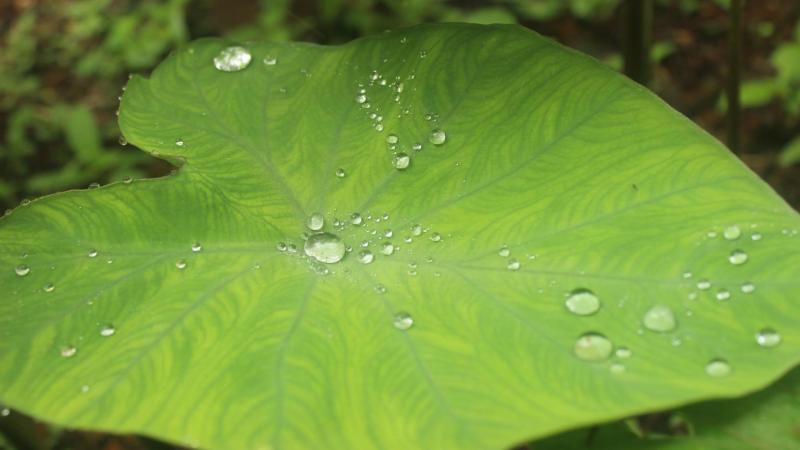
Researchers study the structure of taro leaves to make water-repellent material
The leaves of taro plants are a familiar ingredient in many regional delicacies across India. Featuring in dishes like alu wadi and pathrode, the heart-shaped leaves of this plant have an interesting quality — they are hydrophobic. Liquids that land on their surface do not wet the leaves but instead roll off them.
In a recent study, researchers from the Indian Institute of Technology Bombay (IIT Bombay) have examined how the structure of leaves of the taro plant (Colocasia esculenta) helps in repelling water. Inspired by the honeycomb-like patterns on the surface of the leaf, they created a hydrophobic surface made up of an epoxy-based polymer imprinted on silicon, which could be used to harness water from fog. The study, published in the journal Scientific Reports, was funded by the Department of Science and Technology (DST), Government of India.
When the researchers examined taro leaves, collected from the IIT Bombay campus, under a scanning electron microscope, they saw patterns of pentagons and hexagons on the surface. Looking closer, at the nanoscale level, they found that walls of these patterns had a flake-like texture.
“While the micro-pillar structure that makes lotus leaves hydrophobic have been studied widely, taro leaves did not get much attention so far,” says Prof Rajneesh Bhardwaj from IIT Bombay, who led the study.
Most surfaces pull down the liquid drop that rests on it. For example, if you sprinkle water on a glass surface, the water droplets lie flat. However, on a hydrophobic surface, they tend to be rounder and barely touching the surface. When the researchers gently placed a drop of water on a taro leaf, it sat on the flakes present on the sides of the honeycomb-structured surface, rather than filling up space in these honeycomb structures. Since the water drop touches the surface at fewer points, it gets pulled down less and remains round. The flakes and honeycomb-like cavities, in essence, help in providing the water-repelling effect.
The researchers manufactured a new hydrophobic surface by building hexagonal cavities of varying sizes out of an epoxy-based polymer on silicon, mimicking the taro leaf. Since over 70% of the polygons in the taro leaves were hexagons, they chose them over pentagons as the base geometry to design their bioinspired surface. When they placed a water droplet on their material, the droplet stuck to it and did not slide off when the surface was tilted or turned upside down. The droplet hung on, now taking a pendant shape, since the vertical pull of the surface on the droplet exceeds its weight. The honeycomb structure, which allows the droplet to form a continuous line of contact with the surface, helps it to stick.
Hydrophobic surfaces can be defined by the contact angle of a water droplet. It is measured as the angle between where liquid drop touches the surface and the outer edge of the droplet. Lesser the contact angle, flatter is the blob of liquid and more it wets the surface.
In the bioinspired surface, when the scientists increased the length of the hexagon sides, keeping the thickness of the walls constant, the contact angle increased, and the surface became more hydrophobic. But, if the thickness was increased, keeping the length fixed, the contact angle decreased. This bioinspired surface exhibits contact angle on a par with the taro leaf and could be engineered to achieve desired repellence, they add.
The researchers compared the water repellence of the taro leaf and the bioinspired surface by dropping water onto the surface at different velocities. On the taro leaf, the droplet first widens and wets the surface. Then the droplet rebounds and the contact line closes in while the droplet stretches vertically. Finally, it detaches from the surface. As the velocity of impact increases, the droplet spreads more widely and faster on initial contact and elongates more as it bounces back.
However, in the bioinspired surface, the droplet doesn’t bounce back but attaches itself to it. As it recoils, a small portion of the droplet detaches while the rest of it sticks to the surface. At higher velocities, water fills up the hexagonal cavities more easily and has a smaller contact angle. For all velocities, the contact angle can be increased by reducing the thickness.
These sticky bioinspired surfaces can be potentially used to harvest water from the fog by collecting the condensation. Since moisture can be extracted directly from the air, fog harvesting has been presented as an effective method to meet the water requirements in areas facing scarcity.
“As the next step, we will create such structures on a larger scale, measuring meters, and test them for applications such as fog harvesting,” signs off Prof Bhardwaj.
This article has been run past the researchers, whose work is covered, to ensure accuracy.






